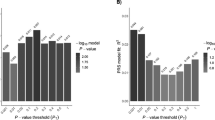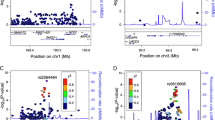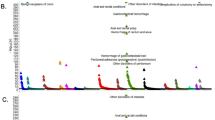Abstract
Celiac disease is a strongly heritable gastrointestinal illness that is an especially important model of the genetically complex multifactorial immune-mediated diseases1. The HLA component of celiac disease (a specific HLA-DQ heterodimer)is largely established and is relatively uncomplicated2,3, and the environmental component (gluten and related grain storage proteins in the diet) is remarkably well understood4. Previous family studies of celiac disease5–8 suggested that there is at least one important non-HLA locus. This locus may be a stronger genetic factor than HLA7, and it apparently has a recessive mode of inheritance5,6,8. We used a three-step genome screening protocol to identify loci that contribute to celiac disease in the western counties of Ireland, a region with the highest prevalence of celiac disease in the world9. The most significant of several possible non-HLA loci that we found was on chromosome 6p about 30 cM telomeric from HLA. It has a multipoint maximum lod score of 4.66 (compared with 4.44 for HLA-DQ) and appears to have a recessive mode of inheritance. Our study localizes and provides strong evidence for linkage of at least one non-HLA locus to celiac disease and may serve as a prototype for an efficient approach to screening the human genome for loci that contribute to complex diseases.
This is a preview of subscription content, access via your institution
Access options
Subscribe to this journal
Receive 12 print issues and online access
$209.00 per year
only $17.42 per issue
Buy this article
- Purchase on Springer Link
- Instant access to full article PDF
Prices may be subject to local taxes which are calculated during checkout
Similar content being viewed by others
References
Michalski, J.P. & McCombs, C.C., Celiac Disease: Clinical features and pathogenesis. Am. J. Med. Sci. 307, 204–211 (1994).
Sollid, L.M., Markussen, G., Ek, V., Gjerde, H.G., Vartdal, F. & Thorsby, E. Evidence for a primary association of coeliac disease to a particular HLA-DQ α–β heterodimer. J. Exp. Med. 169, 345–350 (1989).
Michalski, J.P. et al. HLA-DR,DQ genotypes of celiac disease patients and healthy subjects from the West of Ireland. Tissue Antigens 47, 127–133 (1996).
Marsh, M.N., Gluten, major histocompatiblity complex, and the small intestine. Gastroenterology 102, 330–354 (1992).
Peña, A.S. et al. Genetic basis of gluten-sensitive enteropathy. Gastroenterology 75, 230–235 (1978).
Greenberg, D.A. & Rotter, J.I. Two locus models for gluten sensitive enteropathy: Population genetic considerations. Am. J. Med. Genet. 8, 205–214 (1981).
Risch, N. Assessing the role of HLA-linked and unlinked determinants of disease. Am. J. Hum. Genet. 40, 1–14 (1987).
Hernandez, J.L. et al. Evidence for a dominant gene mechanism underlying coeliac disease in the West of Ireland. Genet Epidemiol. 8, 13–27 (1991).
Mylotte, M.J., Eagan-Mitchell, B., McCarthy, C.F. & McNicholl, B. The incidence of coeliac disease in the West of Ireland. Br. Med. J. i, 703–705 (1973).
Risch, N. Linkage strategies for genetically complex traits III. The effect of marker polymorphism on analysis of affected relative pairs. Am. J. Hum. Genet. 46, 242–253 (1990).
Elston, R.C., Guo, X., Williams, L.V. Two-stage global search designs for linkage analysis using pairs of affected relatives. Genet. Epidemiol. (in the press).
Cordell, H.J., Todd, J.A., Bennett, S.T., Kawaguchi, Y. & Farrall, M. Two-locus maximum lod score analysis of a multifactorial trait: joint consideration of IDDM2 and IDDM4 with IDDM1 in type 1 diabetes. Am. J. Hum. Genet. 57, 92–934 (1995).
Olson, J.M. Likelihood models for linkage analysis using affected sib pairs. Hum. Heredity (in the press).
Greenberg, D.A., Hodge, S.E. & Rotter, J.I. Evidence for recessive and against dominant inheritance at the HLA-linked locus in celiac disease. Am. J. Hum. Genet. 34, 263–277 (1982).
Davies, J.L. et al. A genome-wide search for human type 1 diabetes susceptibility genes. Nature 371, 130–136 (1994).
Morton, N.E. et al. Heterozygous expression of insulin-dependent diabetes mellitus (IDDM) determinants in the HLA system. Am. J. Hum. Genet. 35, 201–213 (1983).
Todd, J.A. Genetic analysis of susceptibility to type 1 diabetes. Springer Semin. Immunopathol. 14, 33–58 (1992).
Field, L.L., Tobias, R. & Magnus, T. A locus on chromosome 15q26 (IDDM3) produces susceptibility to insulin-dependent diabetes mellitus. Nature Genet. 8, 189–194 (1994).
Julier, C. et al. lnsulin-IGF2 region on chromosome 11 p encodes a gene implicated in HLA DR4-dependent diabetes susceptibility. Nature 354, 155–159 (1991).
Bain, S.C. et al. Insulin gene region-encoded susceptibility to type 1 diabetes is not restricted to HLA-DR4-positive individuals. Nature Genet. 2, 212–215.
Collin, P. et al. Coeliac disease associated disorders and survival. Gut 35, 1215–1218 (1994).
Page, S.R., Lloyd, C.A., Hill, P.G., Peacock, I. & Holmes, G.K. The prevalence of coeliac disease in adult diabetes mellitus. Q. J. Med. 87, 631–637 (1994).
Maki, M., Huupponen, T., Holm, K. & Hallstrom, O. Seroconversion of reticulin autoantibodies predicts coeliac disease in insulin dependent diabetes mellitus. Gut 36, 239–242 (1995).
Kruglyak, L. & Lander, E. Complete multipoint sib-pair analysis of qualitative and quantitative traits. Am. J. Hum. Genet. 57, 439–454 (1995).
Erlich, H.A. HLA class II sequences and genetic susceptibility to insulin dependent diabetes mellitus. Baillieres Clin. Endocrinol. Metab. 5, 395–411 (1991).
Polanco, I. et al. Gluten-sensitive enteropathy in Spain: genetic and environmental factors. in Genetics of Coeliac Disease, Proceedings of International Symposium 1979 (ed. McConnell, R. B. ) 221–231 (MTP Press, Lancaster, England, 1981).
Ciulla, T.A., Sklar, R.M. & Hauser, S.L. A simple method for DNA purification from peripheral blood. Anal. Biochem. 174, 485–488 (1988).
Weissenbach, J. et al. A second-generation linkage map of the human genome. Nature 359, 794–801 (1992).
Sheffield, V.C. et al. A collection of tri-and tetranucleotide repeat markers used to generate high quality, high resolution human genome-wide linkage maps. Hum. Mol. Genet. 4, 1837–1844 (1995).
Macaubas, C. et al. Extensive polymorphism of a (CA)n microsatellite located in the HLA-DQA1/DQB1 Class II region. Hum. Immunol. 42, 209–220 (1995).
Weber, J.L. & May, P.E. Abundant class of human DNA polymorphisms which can be typed in a polymerase chain reaction. Am. J. Hum. Genet. 44, 388–396 (1989).
Olerup, O. & Zetterquist, H. HLA-DR typing by PCR amplification with sequence-specific primers (PCR-SSP) in 2 hours: An alternative to serological DR typing in clinical practice including donor-recipient matching in cadaveric transplantation. Tissue Antigens 39, 225–235 (1992).
Bidwell, J.L., Bidwell, E.A. & Bradley, B.A. HLA class II genes: typing by DNA analysis. Bailliere's Clin. Haematol. 3, 355–383 (1990).
Fasman, K.H., Cuticchia, A.J. & Kingsbury, D.T. The GBD (TM) Human Genome Data Base Anno. Nucl. Acids Res. 22, 3462–3469 (1994).
S.A.G.E. (1994): Statistical Analysis for Genetic Epidemiology. Release 2. 2. Computer program available from the Department of Epidemiology and Biostatistics, Case Western Reserve University, Cleveland, Ohio, USA.
Chumakov, I.M. et al. A YAC contig map of the human genome. Nature 377, 175–297 (1995).
Author information
Authors and Affiliations
Rights and permissions
About this article
Cite this article
Zhong, F., McCombs, C., Olson, J. et al. An autosomal screen for genes that predispose to celiac disease in the western counties of Ireland. Nat Genet 14, 329–333 (1996). https://doi.org/10.1038/ng1196-329
Received:
Accepted:
Issue Date:
DOI: https://doi.org/10.1038/ng1196-329



